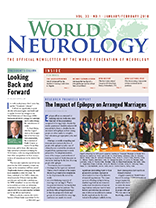Berne, Switzerland, 1931
By Peter J. Koehler
Specialization in medicine started during the second half of the 19th century. Several causes have been presented, including an increase in occupational diversity in Western society, the change from humoral to solid medicine, the appearance of theories on localized lesions versus diffuse causes (reflected for instance by monographs on diseases of one organ), the foundation of asylums and hospitals for particular diseases, and (later on) the fact that certain areas of medicine became too large to be dealt with by one type of physician. Although there was considerable opposition to this change, specialization continued as can be observed by the increasing number of specialized societies and journals, the publication of large specialized handbooks, the introduction of specialties in the medical curriculum, and the organization of congresses for specialist physicians.
Neurology as medical specialization was not among the first new specialties, and in many countries arose associated with psychiatry (which was an early specialization). Other diseases, nowadays belonging to neurology, were taken care of in internal medicine departments or special outpatient clinics arising from internal medicine (for instance outpatient clinics for electrotherapy).
Congresses for General Medicine
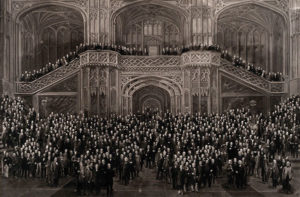
Figure 1. Members of the International Medical Congress, London, 1881. (Courtesy: Wellcome Images)
International congresses for (general) medicine were organized regularly, one of the best known being the one in 1881 in London. According to a report in the BMJ of Aug. 13, 1881, “3,000 men have been gathered in Congress throughout the week, and among them the choicest spirits of the age.” (See Figure 1.) Indeed, well-known names were mentioned, including Pasteur, Lister, Bastian, Bigelow, Erichsen, and Crichton Browne. It was at this congress that the famous discussions on cerebral localization, following Broca’s 1861 clinical findings and the electrical stimulation experiments by Fritsch and Hitzig in 1870, took place and David Ferrier demonstrated his experimental monkeys, urging Jean-Martin Charcot to exclaim that the monkey resembled hemiplegic patients. The large number of visitors at the congress was another indicator of the necessity of future meetings in smaller groups.
1907 Amsterdam Congress; Not Just Neurology
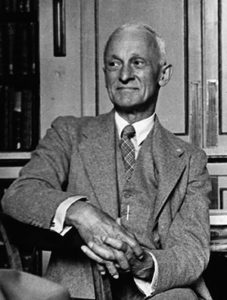
Figure 2. Harvey Cushing (picture taken a few years following the congress; Wellcome Images)
One of the first, possibly the first, neurology meeting, the International Congress for Psychiatry, Neurology, Psychology, and Care for the Insane was organized in Amsterdam in 1907. Even at this early specialized congress, 805 delegates were present (21 nationalities, price for registration 10 guilders/3 $).
Many well-known neurologists met, including the Belgian Arthur van Gehuchten, the Germans Arnold Pick and Hugo Liepmann, and the Swiss Constantin von Monakow. In 1914, the Swiss were organizing an international meeting solely for neurology in Berne. The correspondence between Swiss neurologist Constantin von Monakow and his Dutch colleague and friend Cornelis Winkler tells about the organization in September of that year.
On Aug. 1, 1914, Winkler wrote to Monakow: “I think that if the international relationships will not relax soon, I will not be able to come to Switzerland.” In a post scriptum to the letter, he noted, “I believe this Aug. 1, 1914, will become a historical day.” On the same day, Monakow wrote to him, “The war, the dreaded European war is imminent, and Switzerland too, is preparing to send troops to the threatened borders.” He realized that his colleagues in Europe were engaged in “obvious national and economic tasks and have other thoughts than discussing scientific questions; and that will probably mean – although we have not yet decided definitely – that the Berne Congress that has been prepared so well, will probably not take place.”
Although dozens of letters about resurrecting the International Brain Commission (founded in London in 1903 and an important platform for international communication with respect to neurology, including the basic fields) have been written between neurologists/ neuroanatomists during the period 1918-1931, the organization of the congress finally took place in 1931, now considered the first in a long series, such as the 23rd meeting in Kyoto, Japan (2017).
Proceedings of the Congress
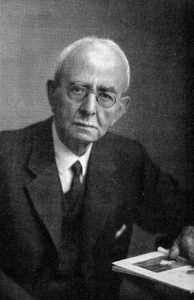
Figure 3. Sir Charles Scott Sherrington (courtesy: Wellcome Images)
It is a pleasure to leaf through the Proceedings of the congress (published in 1932 by Stämpfli, Switzerland). The book was put together by a team of neurologists (Bernard Sachs and Henry Alsop Riley of New York, Charles Dubois, R.F. Fischer, and Pierre Schnyder of Berne), and chaired by Bernard Brouwer of Amsterdam. The introduction was written in four different languages (English, French, German, and Italian).
During the opening ceremonies on Monday, Aug. 31 (1931 at the Casino of Berne), the rector of the local university conferred honorary degrees of medicine to Harvey Cushing (see Figure 2), the famous founder neurosurgeon, who had done experimental research (with Theodor Kocher and Hugo Kronecker) in Berne 30 years previously, and to Sir Charles S. Sherrington (see Figure 3), the well-known neurophysiologist (who would be awarded the Nobel Prize in 1932).
The laudatios were read in Latin. The presidential address, also printed in the four languages, was given by Bernard Sachs, who at the time was also president of the American Neurological Association.
“The purpose of this congress is primarily to establish personal contact and to unite the neurologists of the entire world in the attempt to find a solution to the many important problems engaging their attention; to indicate other problems that will call for study in the immediate future, and to emphasize the important relation that neurology bears to every branch of medical and surgical science. Neurology is the fundamental specialty of medical art. Without a thorough appreciation of its truths, medical and surgical science is like a ship floundering about in a turbulent sea without helm or rudder.”
Presentations
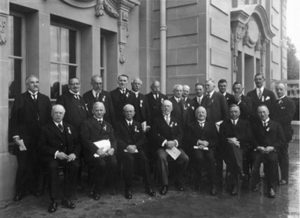
Figure 4. Representatives of the various participating countries in Berne (1931); sitting from left to right: 1 Gheorghe Marinescu (?) 2 Max Nonne 3 Charles Sherrington 4 Bernard Sachs 5 6 and 7: unknown. Standing from left to right 1 unknown 2 Robert Bing 3 Otto Marburg 4 Ottorino Rossi 5 C.U. Ariëns Kappers 6 Henry Markus (?) 7 George Guillain 8 Robert Wartenberg or François Naville (?) 9 unknown 10 Henri Claude (?) 11 Ludo van Bogaert (?) 12 unknown 13 Henry Alsop Riley 14 unknown.
A number of scientific sessions was held during the congress. “Diagnostic and Therapeutic Procedures (Surgical and Otherwise) in Brain Tumors” with presentations by (among others) Clovis Vincent (the Paris neurosurgeon), Robert Foster-Kennedy (New York neurologist who was eponymized with the syndrome combining optic atrophy on one side and papilledema on the other), Wilder Penfield (neurosurgeon from Montreal), Otfrid Foerster (neurosurgeon from Breslau), and Harvey Cushing (with a lecture titled, “The Surgical Mortality Percentages Pertaining to a Series of 2,000 Verified Intracranial Tumors”). A peculiar presentation was the one by Tracy J. Putnam on “Organo-Therapy in Brain Tumors,” not that strange in a period that organotherapy (the use of animal tissue extracts, a precursor of endocrinology) culminated after the introduction of insulin in the early 1920s. Other sessions were on “Muscle Tonus; Anatomy, Physiology and Pathology,” “Neurological Surgery – Therapy,” “Clinical Neurology,” “Clinico-Pathology” (with a demonstration of two educational films on hydrocephalus and Wilson’s disease by the Viennese neurologist Otto Marburg), “Investigative Neurology” (with a film presentation by Walter Rudolf Hess of Zurich, later Nobel Prize laureate, 1949, on localized brain stem stimulation), “Acute Non-Suppurative Infections of the Nervous System” (with presentations by Constantin von Economo, who died a few month after the congress, on encephalitis and Friedrich Lewy on inclusion bodies), “Brain Tumors and Allied Subjects,” “Neuro-Pathology,” “Investigative Neurology” (with C.U. Ariëns Kappers of Amsterdam on “The Brain of Prehistoric and Recent Races,” and Robert Bárány on “The Theory of the Cortical Mechanisms of Association”), and “Clinical and Pathogenetic” (with Robert Wartenberg, then still working in Freiburg in Breisgau, on “Neuritis in the Hand”). The session “Constitutional Problems – Neuroses” could be considered a remnant of the past practice of neurology (with a presentation by the famous Ivan P. Pawlov of Leningrad, on “Experimental Neuroses”), although the association between neurology and psychiatry would continue for decades in many countries. Two sessions on traumatic brain injury included presentations by Charles P. Symonds of London (“The Effects of Injury Upon the Brain”) and Harold G. Wolff / Maurice Levine of Boston on cerebral circulation. The last sessions were on multiple sclerosis/infections, brain tumors, experimental investigative neurology, clinical and biological (issues) with films on extrapyramidal arm reflexes (by Th. B. Wernöe of Copenhagen), and a film on movement disorders of the lower extremities by F. de Quervain (Berne). A picture of the various international representatives was made during the congress. (See Figure 4.)
Neurology an Independent Specialization
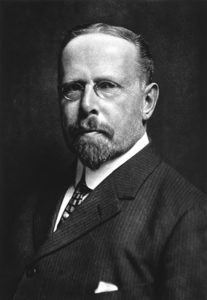
Figure 5. Chairman of the Congress New York neurologist Bernard Sachs (public domain).
On the evening of Friday, Sept. 4, a special conference titled, “Relation of Neurology to General Medicine and Psychiatry in Universities and Hospitals of the Various Countries” was organized at the Bellevue-Palace hotel. Neurologists/neuropsychiatrists from several countries spoke about the situation in their own country (Max Nonne on Germany, Constantin von Economo on Austria, Mieczyslaw Minkowski on Switzerland, Jean Lépine on France, Theodore Weissenburg on the U.S., Ottorino Rossi on Italy, and Bernard Brouwer on the Netherlands). Following the discussion, the chairman, Bernard Sachs, (See Figure 5.) asked the assembly to vote the resolution, as proposed by Otfrid Foerster: “Neurology represents an entirely independent specialty in medicine. Unfortunately, this fact has not been sufficiently recognized in various countries. The First International Neurological Congress hopes that the Universities and Hospital Authorities of the various states will take active steps to further the progress of Neurology.” The resolution was accepted unanimously. The influence of the congress and conference may be recognized by the foundations of several independent university chairs and neurological societies in several European countries.
It is interesting to note that the “Ladies reception committee” (mainly wives of Swiss delegates) is mentioned in the Proceedings with a report of the “Receptions and excursions.” The second International Neurological Congress would be held in London (1935), after the Association of British Neurologists had been founded in 1932 (at the house of Gordon Holmes).
Peter J. Koehler is editor of the History Column. (Visit his website at www.neurohistory.nl.)
